Announcing the 2023–2024 JUMP Into STEM Challenge Winners
National Building Science Competition Heats up as Challenge Winners Are Selected for Final Competition
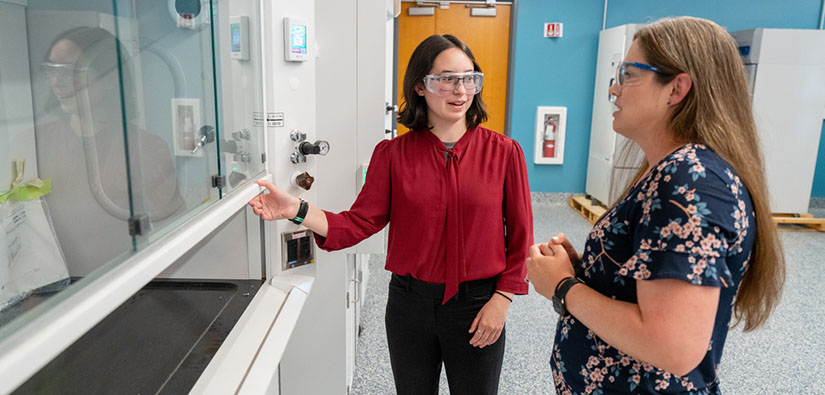
The 2023–2024 JUMP into STEM Challenge Winners include nine teams of college students with diverse backgrounds and academic majors exploring solutions toward an equitable clean energy future through building science. Now in its sixth year, the National Renewable Energy Laboratory (NREL) and Oak Ridge National Laboratory (ORNL) have utilized this competition to provide hands-on experience and mentorship to the next generation of building scientists.
"We're always blown away by the creativity of the students who submit their solutions to the competition and this year is no exception," said researcher Kim Trenbath, who serves as both a manager of the program and acting group manager for Communities and Urban Science Research in the Building Technologies and Science Center at NREL. "It's difficult to choose Challenge Winners from such impressive submissions, but our judges did a great job selecting finalists for what has been one of our most competitive years."
A critical component of the program is its connection to industry. Industry sponsors provide students with helpful insight into potential careers in this sector while also offering opportunities such as the industry partner visit, a summer program that allows JUMP into STEM interns to tour partners' headquarters and meet professionals.
"It's inspiring to see the impact that JUMP into STEM competition has on the future of the buildings industry," said Brenna Holly, senior director of corporate philanthropy at Johnson Controls International, one of JUMP into STEM's 2023–2024 sponsors. "The program not only addresses current industry challenges but also plays a pivotal role in developing the next generation of leaders that will drive sustainable advancements. This year's competition has been particularly exciting, featuring a wide range of innovative solutions that highlight the transformative power of STEM in reshaping the built environment."
This year's competition called upon student teams to find innovative solutions for thermal energy storage, building envelope improvement, and carbon reduction.
JUMP Into STEM Challenge 2023–2024 Winners and Runners-Up
Keepin' It Cool (or Hot)
Winner
Energy Saves Solutions: Mini-Split Thermal Energy Storage System
Embry-Riddle Aeronautical University
Jared Williams, Gianluca Borgese, Martin Rosales, and Spencer Marinac
Electrochemical batteries are the most common form of energy storage used on the grid today, though thermal energy storage (TES) has the advantage of being more cost competitive. The team from Embry-Riddle Aeronautical University designed a modular TES system that works in tandem with a variety of mini-split heat pumps without modifying the unit. This design allows for rapid deployment of the system into the consumer market space, and once installed, the system reduces customers' energy consumption from the grid at peak hours, decreasing their electricity bills.
Second Place
Reducing Barriers to Achieve an Energy-Efficient Lifestyle for Low-Income Families
in the United States of America
Purdue University
Andreas Hoess, Aaron Farha, Levi Premer, and Rebecca Lu
The support of low-income households in existing or newly built subsidized housing to retrofit conventional heating, ventilation, and air conditioning (HVAC) systems with high-efficiency heat pump technology and thermal energy storage will be a key measure to transitioning to an electrified society. This team's project, "OneGrid," seeks to provide an affordable TES heat pump combination that is optimized for communal use in low-income or subsidized housing. With easy installation, retrofit options, a smart control system, and implementation in a microgrid, the installation benefits both users and the power grid.
Third Place
KILN TES
Worcester Polytechnic Institute
Rebekah Shields, Matthew Lydon, Timothy Rinaldi, and Phillip Cass
The team from Worcester Polytechnic Institute proposes a practical solution to conceptualizing, developing, and implementing a TES system to optimize energy consumption and minimize costs. Their proposal involves modification of high-temperature kilns using refractory bricks submerged in sand.
That's a Wrap!
Winner
Detecting, Contracting, Sealing (DCS) – The Community Envelope
University of Nebraska-Lincoln
Israel Bryant, Maddax Frye, Sophie Kudron, and Ema Horner
Individuals in low-income housing disproportionately find themselves in buildings that may have extensive air leakages and are unprotected from the elements. As of today, there are few organizations that work to protect the building envelope. The team from the University of Nebraska-Lincoln proposes the creation of a nonprofit called "Detecting, Contracting, and Sealing," which will take a two-part approach to solving these problems. The first part includes physical inspection and restoration, and the second part includes utilizing government agency funding and accounting for stakeholder needs.
Second Place
Building Facade Sealing Kits
North Carolina Agricultural and Technical State University
Autumn Walton and Amaya Burse
This proposal introduces an innovative do-it-yourself air sealant kit tailored to address the specific needs of low-income families. The user-friendly kit includes step-by-step instructions, identification techniques, and all the necessary materials that empower households to seal gaps and cracks in their home, making it accessible and easy to use for individuals with limited resources and experience. By sealing air leaks, this kit not only improves indoor comfort but also grants economic relief, making it an invaluable tool for low-income families striving to create a more energy-efficient and cost-effective living environment.
Third Place
Bridging Gaps in Energy Efficiency
The University of Texas at Austin
Gaon Ok, Vivien Zheng, and Aakruthi Karthic
This solution aims to empower communities burdened by high energy consumption with accessible and cost-effective solutions that enhance the performance of building envelopes. The team from the University of Texas at Austin is committed to reducing energy inefficiency, improving occupant comfort, and addressing the needs of underserved communities through innovative kits that combine heat control window film and efficient air sealing components. By offering solutions that are practical, sustainable, and accessible, they aim to make significant strides in alleviating energy burden and advancing the quality of living spaces for all.
You and Me, Carbon Free!
Winner
Building-Integrated Algae Photobioreactor Systems for Carbon Sequestration
University of North Carolina at Charlotte
Ankit Soni, Emilio Nava, Felix Ekuful, and Harriet Darkwah
This proposal explores an approach to mitigate carbon dioxide emissions utilizing microalgae in a photobioreactor system integrated with building HVAC systems. Through the process of photosynthesis, the algae efficiently sequester carbon dioxide from the flue gas or exhaust air of buildings, yielding fresh oxygen and biomass. This innovative solution offers a promising approach to sequester carbon dioxide due to building operation and simultaneously produce a sustainable source of biomass.
Second Place
Interlocking Sun-Dried Adobe Bricks (MODIFIED ADOBE – MODUBE)
SUNY College of Environmental Science and Forestry
Aayusha Chapagain and Olayinka Olaosebikan
This team's project, "Interlocking Sun-Dried Adobe Bricks (MODIFIED ADOBE – MODUBE),"
aims to revolutionize the North American building construction industry with sustainable
solutions. MODUBE, an innovative adobe brick, incorporates waste wood ash for structural
strength and aligns with circular economy principles. The incorporation of waste materials
and adherence to carbon reduction goals make MODUBE a sustainable choice for various
stakeholders.
Third Place
Decarbonizing Interior Construction Using Mycelium Based Assemblies
The University of Texas at Austin
Rohaan Saripella and Mason Sirianni
This team from the University of Texas at Austin proposes the use of mycelium-based wall assemblies to provide a greener alternative to typical interior partition wall assemblies for new commercial construction. Mycelium-based walls are made from the vegetative portions of fungi and propagate through a mixture of agricultural waste, recycled paper products, and fungal specimens. This will result in a construction element that provides fewer biohazards, reduces carbon emissions, and reorients labor within the building industry.
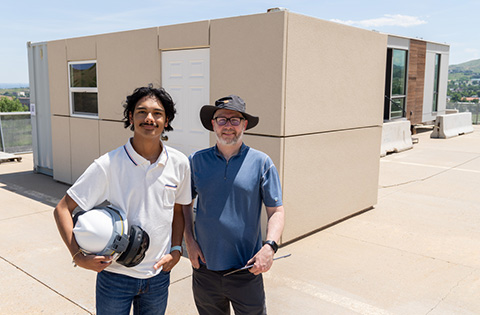
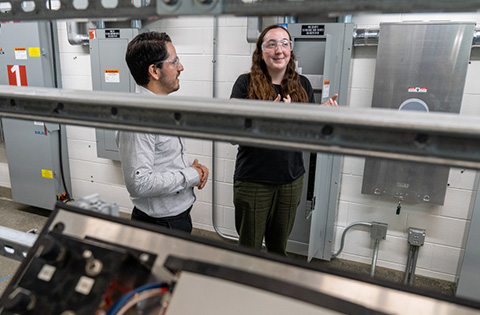
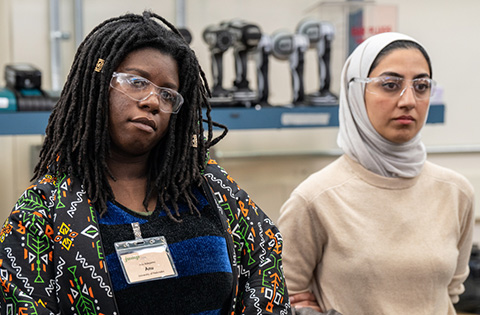
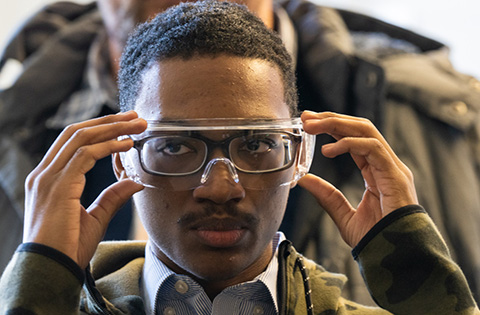
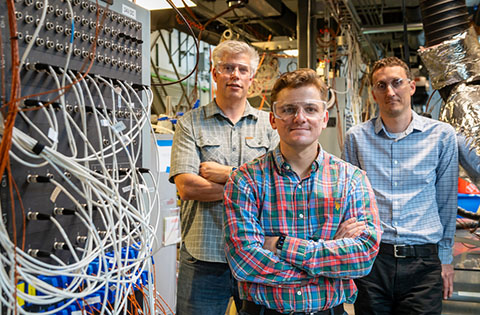
Coming Up Next: JUMP Into STEM Final Competition
JUMP into STEM finalists will present solutions to the challenge topics in person during the 2023–2024 Final Competition, which will be held January 25–26, 2024, at ORNL.
During the event, participants will present to a panel of judges, learn about career paths in building science, network with experts in the field, tour the national laboratory facilities, and more. To culminate the Final Competition, winners will be announced live and offered 10-week, paid internships at NREL, ORNL, or Pacific Northwest National Laboratory (PNNL), where they will gain hands-on experience and receive invaluable mentorship. Interns will also have the opportunity to participate in an industry partner visit.
JUMP into STEM is supported by the U.S. Department of Energy. Visit the Building Technologies Office website for more information on energy-efficient building initiatives.
